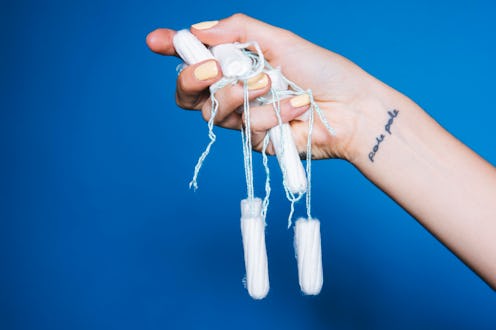
Even though tampons are associated with a time of the month that isn't especially enjoyable or comfortable for many people who menstruate, they can make a period much easier to deal with. They can support you through a long work day, be there in the bottom of your bag when your period surprises you, and even make it more comfortable to sleep through the night. But regardless of how many years you've been menstruating and relying on tampons to take care of the blood for you, there are still plenty of tampon facts that you might not know.
First of all, the tampon origin story is actually really empowering. "Up until the 1970s, tampons were rarely discussed in public to ‘preserve women’s modesty,'" women's health expert Dr. Ashley Margeson, BSN, ND, tells Bustle, "but they actually became widely used during World War II when women were doing many of the ‘men’s’ jobs to aid in the war effort." Since tampons allowed women to enter the workplace with more ease, they took away some of the worry and inconvenience of menstruation while also supporting their ability to work outside the home.
Next time you begin to unwrap a tampon, know that you'll probably be a little more knowledgeable about what you're putting inside your body, thanks to the tampon advice from these experts.
1They Expire
If you discover a wrapped tampon in the bottom of a bag you haven't seen in years, it might seem like a great surprise. But using the tampon might actually not be that great for you. "Although it may be hard to believe that cotton can expire, tampons actually have a shelf-life of approximately five years," Samantha Morrison, a health and wellness expert for Glacier Wellness, tells Bustle. Ditch any dusty tampons left in the pockets of an old suitcase and opt for a newer one instead.
2They Can Cause Discomfort
Your period can be uncomfortable due to a number of symptoms from cramping to headaches. But using your tampons in certain ways could lead to even more problems. Since your vagina is an organ that works to eliminate blood and other substances, it's usually healthier to change it more often, Dr. Margeson says. Wearing your tampons for too long can lead to dryness or itchiness during your period, so be sure to pay attention to any uncomfortable symptoms during that time of the month.
3They Aren't Technically Sterile
Tampons aren't technically sterile, Morrison says, which means that they "can become a breeding ground for all sorts of germs if not stored properly." These germs can pose a significant risk to your vaginal health and lead to infections, so she says to make sure to both double-check any expiration dates on the packaging and store them in a cool, dry place.
4They Can Contain Mysterious Ingredients
"The FDA doesn’t require companies to provide a comprehensive list of ingredients for tampons, pads and liners, so most companies don’t," Jordana Kier, co-founder and co-ceo of reproductive care company LOLA, tells Bustle. Since people who get periods will put a tampon inside their bodies approximately 11,000 times over the course of menstruation, it's important to know what's in them, she says. Opt for products without synthetic fibers and chemical additives and instead go for tampons made of 100 percent organic cotton for peace of mind, Kier says.
5You Probably Shouldn't Leave Them In As Long As You Do
If you're a regular tampon wearer at night, chances are that you keep them in for seven or eight hours. This really isn't a good idea, says Dr. Margeson. "Though super absorbent tampons have been designed for up to 12 hours in length," she says, "because we can’t always guarantee the quality of the manufacturing, I always recommend changing every four hours. Max six." Since your vagina is an organ that works to eliminate blood and other substances, it's usually healthier to change it more often, she says. Wearing your tampons for too long can lead to dryness or itchiness during your period, so be sure to pay attention to any uncomfortable symptoms during that time of the month.
6They Don't Work For Every Person's Body
Chances are, if you find yourself in need of a menstrual product out in public, you'll be able to find a number of people willing to pass you a tampon. But for some bodies, this isn't as easy of a period solution as it is for others. "For women with a retroflexed uterus, tampons aren’t always designed for this change in length," Dr. Margeson says. "So if you find that a tampon insertion is uncomfortable, a gynecologist or pelvic floor physiotherapist can do further investigations with you to determine the positioning of your uterus."
7Choosing The Correct Absorbency Is Important
Tampons are not a one-size-fits-all tool, which is great, because as you probably already know, they come in different "sizes" or absorbencies. It could seem easy to just grab a big box of whatever absorbency you're used to using and pull from it throughout your period, but in actuality, you should probably be a little more strategic. Menstruators have a variety of body shapes, activity levels, flow levels, and lifestyle, so make sure you're paying close attention to how the absorbency you've chosen works for your body, Dr. Jessica Shepherd, MD, MBA, an OB/GYN and women's health expert and U by Kotex partner, tells Bustle. "The pelvis and vagina are shaped very uniquely and also change position when sitting, standing and lying down," she says, and varying your tampon absorbencies as your flow changes throughout the cycle is important to help you stay comfortable.
Whether you love tampons or just find them to be a necessary tool, make sure that you're informed about what you're putting inside your body. Gaining knowledge about menstruation can help you make the best decisions to stay as healthy and comfortable as possible.